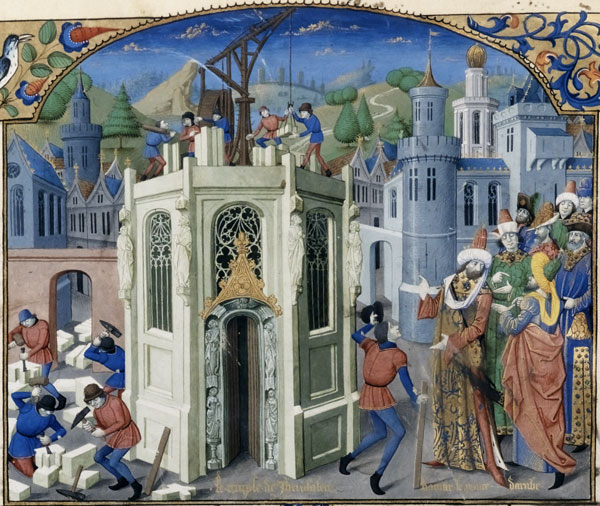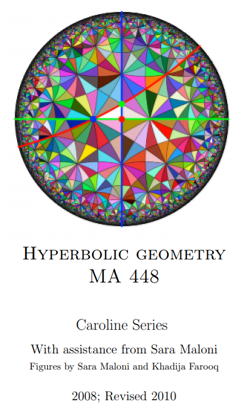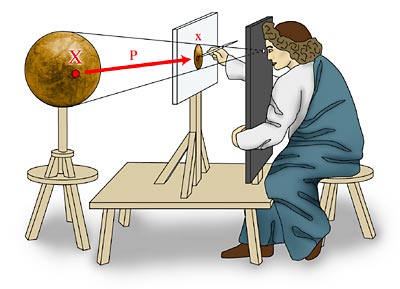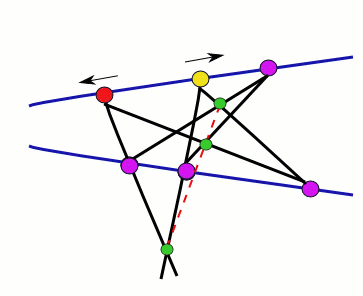Medieval Perspective
When we Look with our Eyes and not with our Mind we can See that Space looks very different from what we Think it is. In Our Space Parallel Lines meet at Infinity.
Around 1400 during the Renaissance Painters started to look at Space with their own Eyes and discovered the Rules of Perspective Drawing.
Between 1600-1800 Perspective Theory changed from a Theory of Art to a Theory of Mathematics called Projective Geometry.
It took 400 Years before a few Mathematicians realized that Projective Geometry was the Foundation of Mathematics and it took another 100 years before Projective Geometry started to influence Physics.
In 1908 Hermann Minkowski discovered that Einstein’s Theory of Special Relativity could be analysed using Projective Geometry. Minkowski created a 4D Space-Time Metric Geometry in which he added one Time Dimension.
Many experiments now show that 4D-Space-Time is not sufficient to incorporate what Time Really is.
The essence of Our Universe is Movement, Expanding Space, and Movement = Space/Time (Space Divided By Time).
Both Time and Space are 3-Dimensional and represent a Different, Reciprocal, Complementary (Dual), View on Movement.
We can move independently in Time OR Space and in Time AND Space (The Chronotope).
The Future is Expanding Space with Infinite Potential.
Time moves behind Space and Scales Space.
About Perspective Drawing
A Mathematical Theory of Perspective Drawing could only be developed when the Renaissance freed painters to depict Nature in a way closer to what they Observed.
In the Middle Ages Social Status was very important. Important People or Buildings were always emphasized.
In the Renaissance the Artists started to look with their own Eyes and Created Pictures where the Viewer looked through the Eyes of the Painter.
The Florentine architect Filippo Brunelleschi (1337-1446) studied Greek Geometry, developed a theory of perspective and undertook painting just to apply his geometry.
The first treatise, Della pittura (1435) by Leone Battista Alberti (1404-72) furnished most of the rules.
Alberti regarded mathematics as the common ground of Art and the Sciences. “To make clear my exposition in writing this brief commentary on painting,” Alberti began his treatise Della pittura, “I will take first from the mathematicians those things which my subject is concerned”.
Alberti stressed that “all steps of learning should be sought from nature“. The ultimate aim of an artist is to imitate nature.

Perspective Machine designed by Albrecht Durer
Alberti did not mean that artists should imitate nature objectively, as it is, but the artist should be especially attentive to beauty, “for in painting beauty is as pleasing as it is necessary“.
The work of art is according to Alberti so constructed that it is impossible to take anything away from it or add anything to it, without impairing the beauty of the whole.
Beauty was for Alberti “the harmony of all parts in relation to one another,” and subsequently “this concord is realized in a particular number, proportion, and arrangement demanded by harmony“.
Alberti’s thoughts on harmony were not new – they could be traced back to Pythagoras – but he set them in a fresh context, which well fit in with the contemporary Aesthetic Discourse.
One of the earliest Artists to produce a book on how to draw in perspective was Albrecht Dürer. As well as discussing geometric methods, he also illustrated his book with a set of woodcuts showing practical tools for accurate perspective drawing. Other Artists like Leonardo Da Vinci developed comparable tools.
About Projective Geometry
Projective Geometry formalizes one of the Central Principles of Perspective Drawing and of Human Perception: Parallel Lines Meet at Infinity.
In Euclidean geometry, constructions are made with Ruler (Line) and Compass (Circle). Projective Geometry only require a Ruler.
In Projective Geometry one Never Measures Any Thing, instead, one Relates one Set of Points to another by a Line.
Alberti was the first to ask what two pictures have in common if two drawing screens are interposed between the viewer and the object, and the object is projected onto both resulting in two different pictures of the same scene.
The basic idea behind Linear Perspective is simple: in every painting an artist creates a “floor” or area of the painting where the figures and/or objects will be placed. The floor ends at a horizon line, and the horizon line has a Vanishing Point or Point of Convergence on it.
The artist then draws parallel lines radiating from the vanishing point outward. Images closest to the vanishing point should appear smaller and closer together, and images farthest from the vanishing point should appear larger and farther apart, giving the impression of depth and space in the painting.
Pappus of Alexandria ( 290 – 350), one of the last great Greek mathematicians of Antiquity, proved that that given one set of points A, B, C on a line, and another set of points a, b, c on another line, then the intersection points X, Y, Z of line pairs Ab and aB, Ac and aC, Bc and bC are also on a Line. This line originates at the Vanishing Point.
Later Desargues (1591-1661) proved Pappus Theorem for Triangels. He proved that the three vertices of one triangle a, b, and c, and those of the other A, B, and C meet in a third point, and that these three points all lie on a common line called the Axis of Perspectivity.
Later Blaise Pascal (1623-1662) proved Pappus Theorem for Conics(Circles, Parabola, Hyperbola) in his ”Essay on Conics” (1640) when he was 16 years of Age.
About the Four Points of the Cross-Ratio
Finally 400 years later in 1803 Lazare Carnot found the answer to the Question of Leone Battista Alberti.
In his book “Géométrie de Position” he proved that the so called “Cross-Ratio” is always preserved in a Projection with One Point of View.
The Cross-Ratio is the Ratio of the Ratio of the Four Points A,B,C,D lying on a Line that intersects the Four Lines defined by a,b,c,d that orginate at the Vanishing Point O. Carnot proved that (AB)(CD)/(AC)(BD) = (A′B′)(C′D′)/(A′C′)(B′D′).
The Cross Ratio is not only the Cross-Ratio of the Four Points A,B,C,D. It is also the Cross-Ratio of the Four Lines and the Three Angles that originate out of the Vanishing Point. In this case (AB)(CD)/(AC)(BD)=Sin(AB) x Sin(CD)/Sin (AC) x Sin (BD).
This principle is called Duality. In 2D-Projective Geometry Connected Points and Lines, called an Incidence, are interchangeable.
There is a corresponding Duality in three-dimensional Projective Geometry between Points and Planes. Here, the line is its own Duality, because it is determined by either two points or two planes.
The Cross-Ratio k is dependent on the Order of the Four Points. It converges to 0 and infinity when k=1 and to -1/2 and 2 when k= -1.
Two examples: 2D: Two distinct Points determine a unique Line and two distinct Lines determine a unique Point. 3-D: Three distinct Points not all on the same Line determine a unique Plane and three distinct Planes not all containing the same Line determine (meet in) a unique Point.
The 24 Permutations of A,B,C and D produce 6 possible values of the Cross-Ratio, depending on the order in which the points are given. If k = 1, the other Cross-Ratio’s are 0 and infinity. This happens when point A = point D. In this case the Geometric Entity is an Equilateral Triangle.
If k = -1, the other Cross-Ratio’s are -1/2 and 2. This is called a Harmonic Cross-Ratio. This happens when the Internal Ratio of AC determinated by B is Equal to the External Ratio of AC determinated by D. When k=-1/2 and 2 the Geometric Entity is a Square.
If the Four Points of the Cross-Ratio are on a Line or a Circle, then the Cross Ratio is a Real Number, otherwise the Cross-Ratio is a Complex Number.
Ruler (Space) and Compass (Time): The Tools of the Geometer
About the Four Layers of Geometry and the Four Points of the Cross-Ratio
In 1872 Felix Klein, published a new Mathematical Research Program called the Erlangen Program under the title Vergleichende Betrachtungen über neuere geometrische Forschungen.
In this program Projective Geometry was emphasized as the Unifying Frame for all other Geometries.
Although lines in the Projective Plane meet in one point of Infinity Klein argued that there could be two points of Infinity if the Projective Plane was a Surface Closed in Itself.
When we look at the Origin of Projective Geometry, the Artist painting A Sphere, Earth, on a Flat Surface, it is not difficult to realize that this Closed Surface is a Sphere.
.
Geometry is now divided into Four Layers. Each Layer adds a set of Assumptions that creates certain Invariants for that Layer.
An invariant is a property of a configuration of Geometric Entities that is not altered by any transformation belonging to the specific layer.
A transformation is an operation applied to a Geometric Entity. The most common transformations are Translation, Rotation and their Combinations (Reflection).

What we will see is that the Four Points of the Cross-Ratio are highly related to the Four Layers. In Every Higher Layer One Point of the Cross-Ratio is moved to the Internal Landscape, the Mind, of the Observer. This principle is called “As Within so Without“.
The First and most fundamental Layer is the Layer of Projective Geometry. This is the Layer of Human Perception and is invariant under the Cross-Ratio also called a Moebius Transformation.

The Second Layer is called Affine Geometry. In this layer Parallel Lines are preserved and the Assumption of a Plane at Infinity, the Horizon, is created. This Plane generates Parallel and Orthogonal Relationships between Geometric Entities by placing One of the Four Points of the Cross-Ratio in the Plane at Infinity.
Affine Geometry is Euclidean Geometry with congruence (something is the same when Shape and Size are the Same) and a metric (a definition of a Distance) left out. An affine transformation preserves straight lines and ratios of distances between points lying on a straight line.
This the layer of the Emotions, “the harmony of all parts in affinity to one another” of Leone Batista Alberti. In Affine Geometry the Frame of Reference of the Painter, the Floor, is created. On this Floor, the Horizon, the Plane at Infinity is drawn. From the Point of View of the Observer, it is not possible to Judge Distance or the-Sameness because a given Visual Object may be Large and Far away or Small and Close.
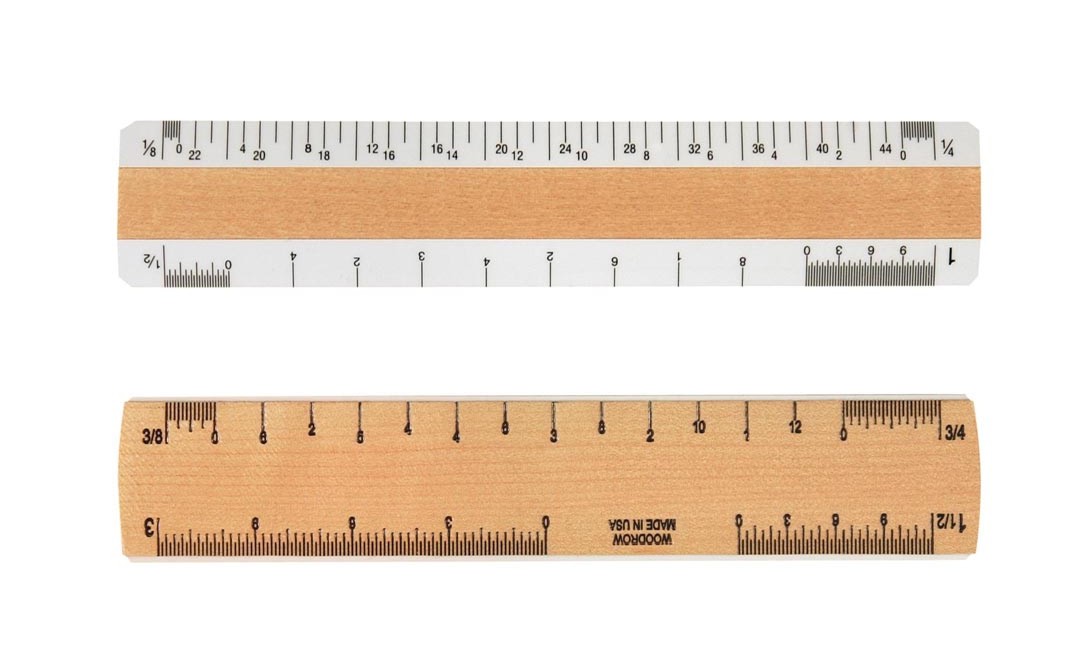
In Eucludian Geometry A Ruler contains a Fixed Scale
The Third Layer, Metric Geometry, adds the concept of Distance (Metric, Scale) to the Affine Layer. A Distance is a relation between Two Points of the Cross-Ratio. This is the Layer of the Painter, Creator, Observer, who creates his own Distance to the Distances he is Painting in the External Frame he is looking at.
Since Projective Space is the Space of Actual Perception, the true function of Metric Space is the Coordination of Various Perspectives. This is illustrated in Perspective Drawing, in which there are always Two Perspectives being Coordinated—the Vanishing Point and a Point just behind the Eyes of the Observer. Each of these is an instance of the One Point at Infinity.
The last, Fourth, Layer is the layer of Euclidian Geometry. In Euclidean Geometry Distance is Fixed (not Relative) and Scaled to a Unity (Meters). This leaves us with just One Point of the Cross-Ratio, the Unity, the One.
Between 1926 and his death in 1983 Alfred Tarski worked on the Axiomatization of Euclidean Geometry. In Tarski’s system there is only one type of Object: the One, The Point.
There are just two Geometrical notions between Points: the Ternary Relation of “in-Betweenness” and the Quaternary Relation of “Equidistance” or Congruence. Betweenness captures the Affine aspect of Euclidean Geometry; Equidistance/Congruence, its Metric aspect.
This is the Layer of the Human Expectation who has not Distanced Itself and is Looking Outside Through a Small Hole at the Future. The Expectation considers the Future as an Extension of the Past (Memory).
In Euclidian Geometry we have to Move Outside to the Objects to Measure their Distance and the Sameness with a Pre-Defined Unity.
If we don’t move to the Object we will measure an Illusion.
About Space measured by Time and Space measured by Space
The Ancient Sumerians knew that the Length of one side of a Hexagon is the same length as is the Radius of the Circle that circumscribes this Hexagon (See Pascals Theorem).
They also knew that the Stars of the Constellations of the Zodiac shift Counterclockwise, at the rate of 72 years/degree, because of the Precession of the Earth’s axis. One Wobble takes 25.920 years.
The length of one side of the Earth Hexagon is therefore the Distance traveled by the Constellations of the Zodiac along the horizon during 25.920/6=4,320 years.
They then subdivided this distance by 7,200 which produced the Royal Mile that was subdivided into 1,760 Royal Cubits.
Before 3.117 BC the complete Earth was covered with a uniform Geodesic System that was based on the Rotation and Precession of the Constellations of the Zodiac. This System was implemented in the Megaliths.
At that Time Space was measured by Time.
The Physical System of the Megaliths was destroyed by the Great Flood of 3.117 BC but the Metric System survived thousands of years until the French Revolution.
On the 8th of May, 1790, Charles Maurice de Talleyrand at the end of the French Revolution, proposed before the National Assembly in Paris a Change to a Decimal Measurement System.
The Academy of Science recommended that the new definition for a Meter be equal to 1/10,000,000 of the distance between the North Pole and the Equator, and this was accepted by the National Assembly in 1791.
From that Time on Space was measured by Space.
Why the Future contains Infinite Possibilities

A Painter or a Human always looks Forwards in Space. If there are Parallel Lines visible they all Converge to a Vanishing Point at The Horizon. The Horizon is a Parallel Line at Infinity.
We all know that the Parallel Line of the Horizon is caused by the fact that the Earth is a Moving Sphere. This Moving Sphere moves around other Spheres that move around other Spheres.
The Rotation of the Spheres in Space is used as a Clock. Every time when the Cycle of the Spheres repeats itself we add one unit to a standard Time-Measure. One Sun Cycle is named a Year. One Cycle of the Precession takes 25,920 Years.
We Measure our Time by the Cyclic Movement of Objects in Space. The Cyclic Movements caused by the Rotations of Objects around Objects (around Objects) is really a Rotating Rotating Rotation, a Spiraling Spiral.
We don’t live in the Sphere but we live and Move on the Surface of a Moving Sphere. That is why our Geometry is an Elliptic Geometry (or Projective Geometry).
Euclides and Pythagoras were aware of Projective Geometry (See also Pappus) but the Scientists of the Enlightenment started to interpret their Theory with a Different Eye. They saw Numbers in a completely different way the Greek did.
The Scientist disconnected Number from Magnitude (Form) and created an Abstract Static Number Theory and an Abstract Static Theory of Physics. The Movement of our Universe, the Ether, came to a stilstand.
The Theory of Perspective Drawing, based on our Real Perception of Reality, is the same theory that generated Projective Geometry. We are now back to Normal again.
In the blog about Geometric Algebra I wrote about a very Independent Thinker called Dewey B. Larson.
He reinvented Physics and Projective Geometry in his own way, Calculated all the well known Physical Constants and based his Theory on a simple well know Assumption that Space and Time are Reciprocal (A Ratio of Ratio’s , the Cross-Ratio) because Velocity= dS(pace)/dT(ime).
Moving Movement is the Essence of our Reality.
What Larson calls “Motion” is the Ether Wind (or the Higgs Field) the Velocity which was measured in the North-South (Z) direction at 208 km/s in 1933 by Dayton C. Miller.
Einstein believed the results of the Michelson-Morley Experiments in 1887 that “proved” that the Moving Ether was non-existent. Now we know that the experiments were wrong. Einstein also did not believe that Space was Expanding. At this moment the Expanding Universe is confirmed by many observations.
When Space Expands, Time Compresses and fills up the Space to Keep Balance. Time Scales Space.
Space moves to Infinity. Time Moves to the Inverse of Infinity, Zero. Space is measured by the Linear Visible Scalar Number-System. Time is Measured with the Rotational Invisible Imaginary Number System.
Expanding Space is Linear Motion. Time is the Spiraling Motion of the Vortex.
Space is Yang and Time is Yin. Yin is feminine, Curved, Rotational, smooth or cold. Yang is masculine, Straight, Linear, rough or hot.
Space and Time are Complementary Duals that Move Around the Void.
If we look at the Human Perspective we now are able to understand what Time and Space Really are.
When we Look Forward we Experience Space. Time is always Behind our Back.
Human Senses and Conventional, Scientific Equipment can only Look Forward and therefore Measure Space (Distance) and the Change of Space (Velocity, Acceleration).
This is a Limitation of our Physical Sensory System, which evolved to measure Space, Scaled by Time, to produce what we Perceive as Causality–a Linear Ordering of Events.
Without the Cause-and-Effect System, the Sensory World of Space would just become Chaos.
Time, History, is Always Behind Us and Space, The Future, The Adjacent Possible, with Infinite Possibilities, is Always in Front of Us.
Let’s Move.
LINKS
About Pythagoras and Heliopolis (Egypt)
Paul Dirac: About Physics and Projective Geometry
About Expanding Space and Not-Euclidian Geometry
About the Mathematics of Perspective
Pictures of the Projective Plane
About the Reciprocal Theory of Dewey B. Larson
A Video about Mobius Transformations
About Projective Geometry and our Senses
About Projective Geometry and Geometric Algebra
About Time and Paranormal Experiences
A Textbook about Metric Geometry
About Alchemy and the Klein Bottle
About the Human Sensory System
Stuart Kaufmann: About the Adjacent Possible
Share This Post
Tags: Affine Geometry, Albrecht Durer, Alexandria, Alfred Tarski, Art, B, Beauty, Blaise Pascal, C, caption, cross ratio, D. In, D. It, D. When, dark middle ages, Desargues, Dewey B. Larson, duality, Elliptic Geometry, emotions, Ether, Euclidean geometry, Felix Klein, Filippo Brunelleschi, florentine architect, geometric algebra, geometry, God, Harmony, imagination, layer, Lazare Carnot, leonardo da vinci, Leone Batista, leone battista alberti, Line, Metric Geometry, O. Carnot, Pappus of Alexandria, Pascal, Pattern, Perspective, point, Projective Geometry, pythagoras, Ratio, renaissance, Rotation, Sam, Space, time, Translation, Trinity, unity, Universe


